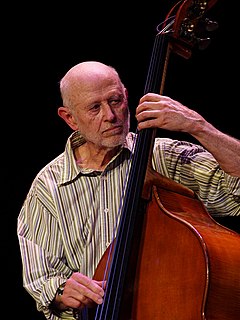
Steve Lacy, born Steven Norman Lackritz in New York City, was an American jazz saxophonist and composer recognized as one of the important players of soprano saxophone. Coming to prominence in the 1950s as a progressive dixieland musician, Lacy went on to a long and prolific career. He worked extensively in experimental jazz and to a lesser extent in free improvisation, but Lacy's music was typically melodic and tightly-structured. Lacy also became a highly distinctive composer, with compositions often built out of little more than a single questioning phrase, repeated several times.

George Lowen Coxhill, generally known as Lol Coxhill, was an English free improvising saxophonist and raconteur. He played the soprano or sopranino saxophone.

Evan Shaw Parker is a British saxophone player who plays free jazz.

Kenneth Vincent John Wheeler, OC was a Canadian composer and trumpet and flugelhorn player, based in the U.K. from the 1950s onwards.

Stanley William Tracey was a British jazz pianist and composer, whose most important influences were Duke Ellington and Thelonious Monk. Tracey's best known recording is the 1965 album Jazz Suite Inspired by Dylan Thomas's "Under Milk Wood", which is based on the BBC radio drama Under Milk Wood, by Dylan Thomas.

Barre Phillips is a jazz bassist. A professional musician since 1960, he migrated to New York City in 1962, then to Europe in 1967. Since 1972 he has been based in southern France where in 2014 he founded the European Improvisation Center.

The Vortex Jazz Club is a music venue in London, England, started by David Mossman in the 1980s.
Emanem Records is a record company and independent record label founded in London, England in 1974 by Martin Davidson and Madelaine Davidson to record free improvisation.
The Bracknell Jazz Festival was a major showcase for British modern jazz in the 1980s. The festival was known for attracting a largish audience for free improvisation, modern jazz composition and all kinds of British modern jazz in general.
Bruce Turner was an English jazz saxophonist, clarinetist, and bandleader.
George Haslam is an English avant-garde jazz saxophonist. Haslam's horns of choice are the baritone saxophone and the tárogató.
Donald Arthur Albert Weller was an English jazz musician, tenor saxophonist, and composer.
Stan Robinson was an English jazz tenor saxophonist and flautist.
Pete Jacobsen, sometimes credited at Peter Jacobsen, was an English jazz pianist.
Simon Richard Spillett is a multi-award winning English jazz tenor saxophonist. He has won the BBC Jazz Awards Rising Star (2007), Jazz Journal's Critics' Choice album of the Year (2009), the British Jazz Awards Top Tenor Saxophonist (2011), the Services to British Jazz award (2016).

John Russell is an acoustic guitarist who has worked in the field of free improvisation since the 1970s. He has promoted concerts and has appeared on more than 50 recordings.

Thomas Borgmann, born in 1955 in Münster, is a German musician and composer of Jazz, free Jazz, and free improvisation music.

Three Blokes is a live album by saxophonists Lol Coxhill, Steve Lacy and Evan Parker recorded in Berlin in 1992 and first released on the FMP label in 1994.

French Gigs is a 1983 live collaborative album of improvised experimental music by Lol Coxhill and Fred Frith. It was recorded live in France in Limoges and Poitiers in October 1978, and in Reims in 1981. The album was released on LP by AAA in 1983, on CD by AYAA in 1991, and again on CD by Klanggalerie in 2020. The 1991 release includes a new track recorded via correspondence in 1991–92 by Coxhill in London and Frith in Munich, while the 2020 release includes the extra 1991 track, plus another new track recorded in Aubervilliers, France in 1999, the last performance by Coxhill and Frith. The 2020 release was re-mastered by Myles Boison.
Michael Cooper is an English guitarist and singer-songwriter. Initially coming to attention as a country blues performer, his later work also straddles jazz, Polynesian, ambient, and various experimental and improvisational styles.
















